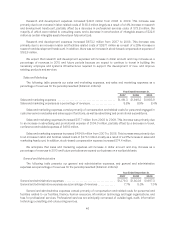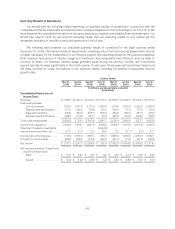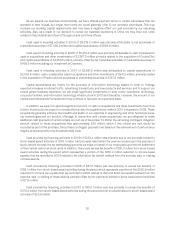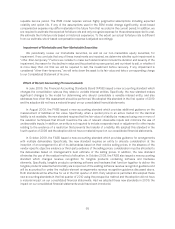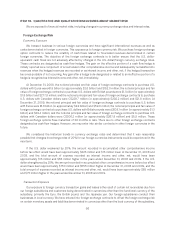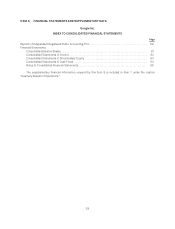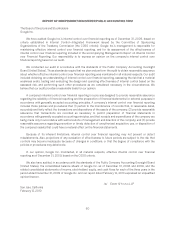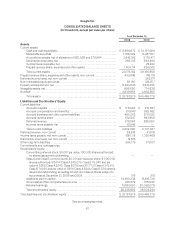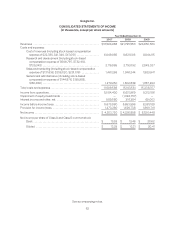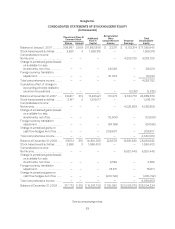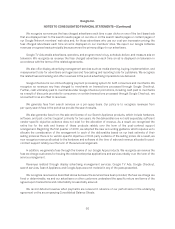Google 2009 Annual Report Download - page 74
Download and view the complete annual report
Please find page 74 of the 2009 Google annual report below. You can navigate through the pages in the report by either clicking on the pages listed below, or by using the keyword search tool below to find specific information within the annual report.ITEM 7A. QUANTITATIVE AND QUALITATIVE DISCLOSURES ABOUT MARKET RISK
We are exposed to financial market risks, including changes in currency exchange rates and interest rates.
Foreign Exchange Risk
Economic Exposure
We transact business in various foreign currencies and have significant international revenues as well as
costs denominated in foreign currencies. This exposes us to foreign currency risk. We purchase foreign exchange
option contracts to reduce the volatility of cash flows related to forecasted revenues denominated in certain
foreign currencies. The objective of the foreign exchange contracts is to better ensure that the U.S. dollar-
equivalent cash flows are not adversely affected by changes in the U.S. dollar/foreign currency exchange rates.
These contracts are designated as cash flow hedges. The gain on the effective portion of a cash flow hedge is
initially reported as a component of accumulated other comprehensive income and subsequently reclassified into
revenues when the hedged revenues are recorded or as interest income and other, net, if the hedged transaction
becomes probable of not occurring. Any gain after a hedge is de-designated or related to an ineffective portion of a
hedge is recognized as interest income and other, net, immediately.
At December 31, 2008, the notional principal and fair value of foreign exchange contracts to purchase U.S.
dollars with Euros were €1.9 billion (or approximately $2.6 billion) and $152.0 million; the notional principal and fair
value of foreign exchange contracts to purchase U.S. dollars with British pounds were £1.1 billion (or approximately
$1.8 billion) and $277.9 million; and the notional principal and fair value of foreign exchange contracts to purchase
U.S. dollars with Canadian dollars were C$229.7 million (or approximately $202.2 million) and $21.8 million. At
December 31, 2009, the notional principal and fair value of foreign exchange contracts to purchase U.S. dollars
with Euros were €1.6 billion (or approximately $2.2 billion) and $59.0 million; the notional principal and fair value of
foreign exchange contracts to purchase U.S. dollars with British pounds were £809.1 million (or approximately $1.3
billion) and $39.4 million; and the notional principal and fair value of foreign exchange contracts to purchase U.S.
dollars with Canadian dollars were C$306.2 million (or approximately $267.9 million) and $5.9 million. These
foreign exchange options have maturities of 36 months or less. There are no other foreign exchange contracts
designated as cash flow hedges. However, we may enter into similar contracts in other foreign currencies in the
future.
We considered the historical trends in currency exchange rates and determined that it was reasonably
possible that changes in exchange rates of 20% for our foreign currencies instruments could be experienced in the
near term.
If the U.S. dollar weakened by 20%, the amount recorded in accumulated other comprehensive income
before tax effect would have been approximately $325 million and $15 million lower at December 31, 2008 and
2009, and the total amount of expense recorded as interest income and other, net, would have been
approximately $15 million and $68 million higher in the years ended December 31, 2008 and 2009. If the U.S.
dollar strengthened by 20%, the amount recorded in accumulated other comprehensive income before tax effect
would have been approximately $750 million and $555 million higher at December 31, 2008 and 2009, and the
total amount of expense recorded as interest income and other, net, would have been approximately $85 million
and $75 million higher in the years ended December 31, 2008 and 2009.
Transaction Exposure
Our exposure to foreign currency transaction gains and losses is the result of certain net receivables due from
our foreign subsidiaries and customers being denominated in currencies other than the functional currency of the
subsidiary, primarily the Euro, the British pound, and the Japanese yen. Our foreign subsidiaries conduct their
businesses in local currency. We have entered into foreign exchange contracts to offset the foreign exchange risk
on certain monetary assets and liabilities denominated in currencies other than the local currency of the subsidiary.
56


